 There were no science books on the YALSA Award for Excellence in Nonfiction for 2016. Nor in 2015. Nor 2014. Bomb in 2013 was sort of a science book, so we’ll count that. And Moonbird that year certainly was. Yet it’s often surprising how consistently science and nature get overlooked when they’re handing out awards for nonfiction. According to my sources, science writers are complaining about this fact, and with good reason. When you create an award for nonfiction and then hand it consistently to biographies, you are, however unintentionally, sending a message.
There were no science books on the YALSA Award for Excellence in Nonfiction for 2016. Nor in 2015. Nor 2014. Bomb in 2013 was sort of a science book, so we’ll count that. And Moonbird that year certainly was. Yet it’s often surprising how consistently science and nature get overlooked when they’re handing out awards for nonfiction. According to my sources, science writers are complaining about this fact, and with good reason. When you create an award for nonfiction and then hand it consistently to biographies, you are, however unintentionally, sending a message.
On the children’s side of things the Robert F. Sibert Medal fares a bit better. In 2016 none of the books were science or nature related, but in 2015 we had Neighborhood Sharks and in 2014 Parrots Over Puerto Rico by Susan L. Roth and Cindy Trumbore actually took home the Medal itself with Look Up! Bird-Watching in Your Own Backyard by Annette LeBlanc Cate getting an Honor. You go, Sibert committees!
In their honor, I dedicate today’s list to the lovely science and nonfiction books that were published in 2016 with a hat tip to Melissa Stewart for inspiring me to do this list in the first place.
2016 Science and Nature Books for Kids
FICTION PICTURE BOOKS
Honoring those books willing to add a little science and nature in their mix. Extra points for backmatter.
Ada Twist: Scientist by Andrea Beaty
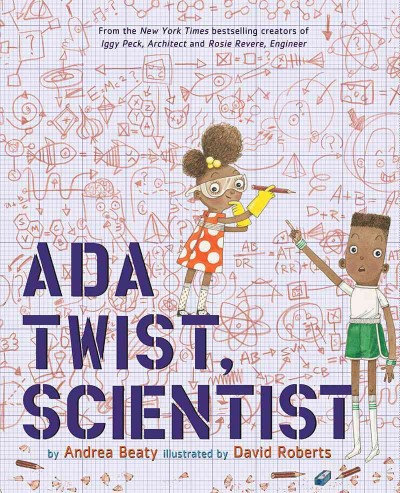
Unless I’m much mistaken, she’s still topping the New York Times bestseller list in the picture book category. I’ll give you some moments to take in the vast implications of this. Pairs particularly well with the upcoming film Hidden Figures.
Baby Loves: Aerospace Engineering!/Quarks! by Ruth Spiro, ill. Irene Chan

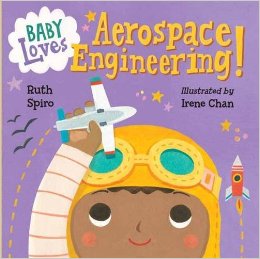
I defended this to you when I put it on the board book list, and I’d willingly do so now. Don’t just assume that due to their format these are meant solely for babies. It’s a kitchy idea that yields a lot of plum rewards. Big concepts are broken down for young people. I can get behind that.
Because of an Acorn by Lola M. Schaefer & Adam Schaefer, ill. Frann Preston-Gannon

It’s the ciiiiiiircle of liiiiiife . . . and it mooooooves us alllllllll . . .
Coyote Moon by Maria Gianferrari, ill. Bagram Ibatoulline

Apparently coyotes roam my own neighborhood’s streets in the summer. I’ve never seen them, but I’m willing to believe it. Jaw-droppingly gorgeous with a surprisingly gripping text, this is sort of like a more fictionalized version of the aforementioned Neighborhood Sharks, only this time with coyotes. In hindsight, I should have put this on the readaloud list too. GREAT readalouding.
Faraway Fox by Jolene Thompson, ill. Justin K. Thompson

The book follows a single fox blocked off from its fellows by a highway. Humans construct a tunnel under the road for wildlife and the fox is reunited with its kind. Information appears at the end about the real world tunnels, how they are constructed, and some of the challenges they fact. The art, for the record, is also a real draw here. Luscious.
Follow the Moon Home: A Tale of One Idea, Twenty Kids, and a Hundred Sea Turtles by Philippe Cousteau & Deborah Hopkinson, ill. Meilo So
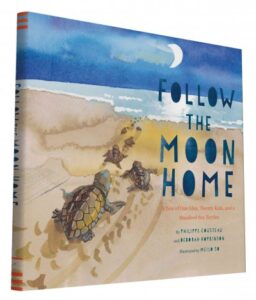
The only Meilo So book out this year? Nope, there’s one coming up later (see if you can guess what it is). Here, a girl attempts to save loggerhead sea turtle babies from man-made light, which means she has to engage in some pretty serious activism. A very cool story, and one I’ve not seen told before.
From Wolf to Woof!: The Story of Dogs by Hudson Talbott

This pairs particularly well with . . .
Grandmother Fish: A Child’s First Book of Evolution by Jonathan Tweet, ill. Karen Lewis

. . . this book. Both cover evolution to a certain extent. This scrappy little Kickstarter title covers ground that few books have on evolution.
Mad Scientist Academy: The Weather Disaster by Matthew McElligott
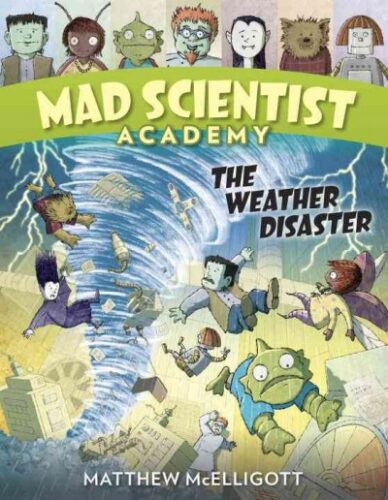
Not a lot of good weather books out this year. This one’s filling a 2016 gap.
Octopus Escapes Again by Laurie Ellen Angus

I’m oddly partial to this adorable book and the creature behind it. Always makes me think of this stranger still video, of course.
Olinguito, from A to Z! / Olinguito, de la A a la Z! by Lulu Delacre
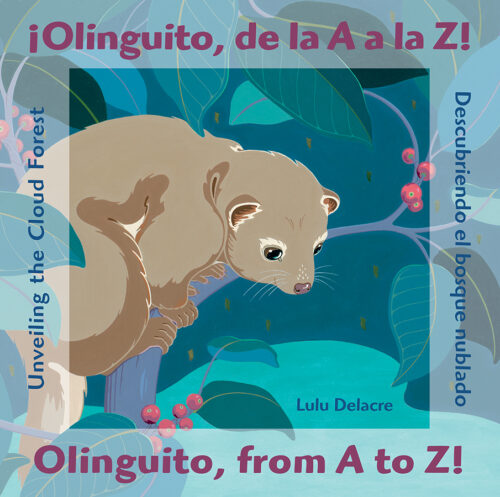
Sure, it’s an alphabet book. Sure it’s bilingual. But it’s actually a really delightful trip into the cloud forest to talk about “discovering” a new animal. Drills home to kids the fact that this is still being done today, barring the destruction of said cloud forest.
Otters Love to Play by Jonathan London, ill. Meilo So

It’s the second Meilo So title on this list today! Hooray! And otters basically just sell themselves. In writing this part of today’s list I just wasted a lot of time watching otters on YouTube for inspiration (have you seen the one of the baby sleeping on its mommy?). In any case, this lives up to its subject matter.
NONFICTION CHILDREN’S BOOKS
Animals by the Numbers: A Book of Infographics by Steve Jenkins

I just recommended this book to a colleague looking for a book to give to a 7-year-old who loves facts and figures and animals too. Couldn’t have come up with anything better! Plus, it’s where I learned that the peregrine falcons that nest on my library every year are the fastest birds in the world.
A Beetle Is Shy by Dianna Hutts Aston, ill. Sylvia Long
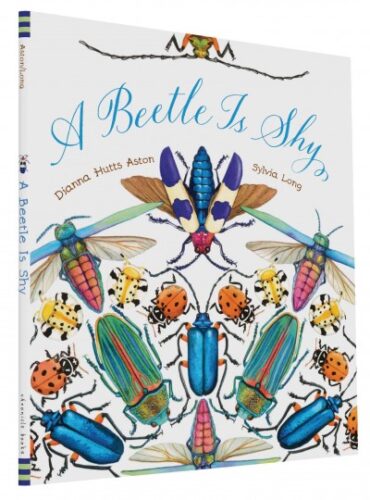
This is a long-standing series but it doesn’t appear to be slowing down in any way, shape, or form. Distinctly fabulous.
The Deadliest Creature in the World by Brena Z. Guiberson, ill. Gennady Spirin
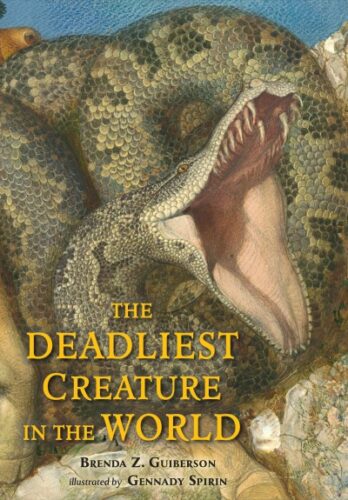
I’m a sucker for a Guiberson/Spirin combo any day of the week. Actually, I’m a sucker for Spirin, period, but his work with Guiberson over the years has never produced a melon. Plus, how do you top that title? Answer: You don’t.
Deep Roots: How Trees Sustain Our Planet by Nikki Tate

I was blown away with this book. Seriously floored. You go into it thinking it’s just another gee-aren’t-trees-great title and what you get instead is this enormously in-depth, serious consideration of how they contribute to the earth. We’ve all heard the statistics on how much oxygen in the atmosphere they produce, but this was the first children’s book I’ve ever read that attempted to explain precisely how their root system works. I’d listened to a RadioLab episode (From Tree to Shining Tree) that explained this and I’m still shocked by the implications. Well done Ms. Tate for filling this book with such pertinent, incredibly up-to-date information!
Dining With Dinosaurs: A Tasty Guide to Mesozoic Munching by Hannah Bonner
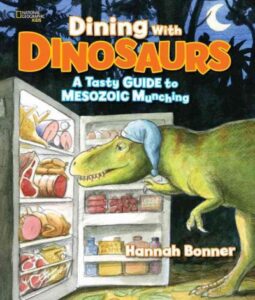
I’m not just sticking this on here because I need a dino title. Trust me, my library shelves are good in that area. But this took a distinctly deep and delightful look at a topic I would have told you had already been covered. Turns out, not so much. A must-add.
Does a Fiddler Crab Fiddle? by Corinne Demas & Artemis Roehrig, ill. John Sandford
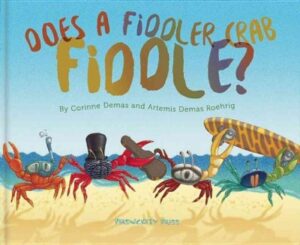
I honestly thought the book was just going to start with fiddler crab and then move on to other animals with evocative names. Nope. Demas and Roehrig are in it for the long haul. The long fiddler crab haul. Good on them!
Feathered Dinosaurs by Brenda Z. Guiberson, ill. William Low
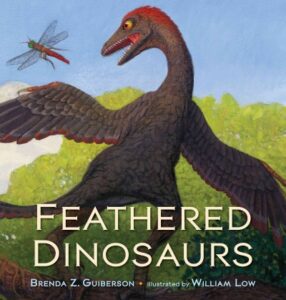
Because you can’t have enough dinosaurs. Or enough Guiberson, for that matter.
Flying Frogs and Walking Fish: Leaping Lemurs, Tumbling Toads, Jet-Propelled Jellyfish, and More Surprising Ways That Animals Move by Steve Jenkins and Robin Page
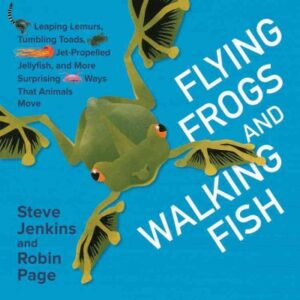
I’d cut that title way way down, but that’s the only thing I’d cut from this highly engaging title (plus it’s always great to see Jenkins and Page working together again).
How Much Does a Ladybug Weigh? by Alison Limentani
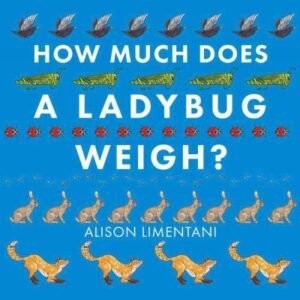
I put this on the math list not too long ago, but it’s also a really interesting, very young, science title. When you consider how much each animal weighs, you find yourself having your assumptions consistently challenged. Math and science = best buds.
I Am NOT a Dinosaur by Will Lach, ill. Jonny Lambert

My college, for whatever reason, owned the skeleton of a giant sloth. I remember seeing it for the first time on display, just utterly baffled by what I was looking at. Sloths were giants once? If you’ve a kid, hand them this book and they’ll be able to know this information far sooner than my sad college-aged self.
If You Are a Kaka, You Eat Doo Doo: And Other Poop Tales from Nature by Sara Martel, ill. Sara Lynn Cramb
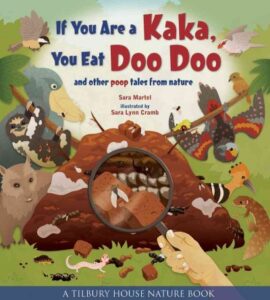
That title’s gonna turn off a bunch of folks right from the start. Maybe that’s not the worst thing, since it really is a book entirely about poop. That said, it’s not gross about it. I mean, there are gross things in it (one word: smearing) but they’re presented in a very matter-of-fact way. If you buy only one poop book this year . . .
My Book of Birds by Geraldo Valerio
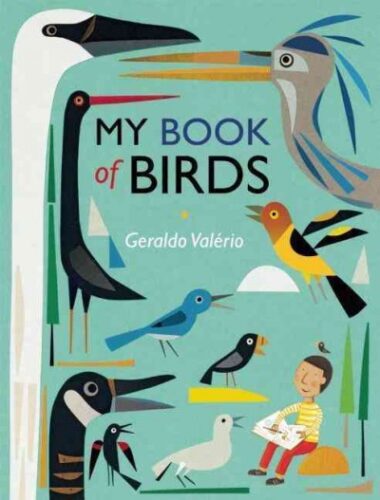
Shockingly lovely from start to finish. A science picture book coffee table book, if you take my meaning.
Natumi Takes the Lead: The True Story of an Orphan Elephant Who Finds Family by Gerry Ellis with Amy Novesky
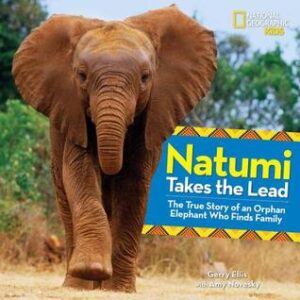
Such a good story, and a good readaloud too. I’d normally avoid any book that traipses this close to anthropomorphism but Gerry and Amy are very careful to place everything in terms true to a baby elephant. Could actually work as a graduation gift picture book as well, come to think of it.
Pink Is for Blobfish: Discovering the World’s Perfectly Pink Animals by Jess Keating, ill. David DeGrand
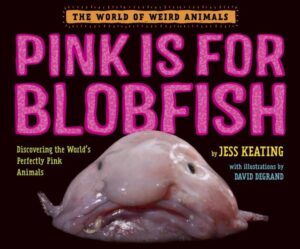
Not solely about the blobfish, alas, but still worth your time thanks to the sheer number of facts packed into these pages.
Plants Can’t Sit Still by Rebecca E. Hirsch, ill. Mia Posada

A cute premise. Shows all the different ways that plants get up and go go go!
The Polar Bear by Jenni Desmond

Though it’s not sourced properly (no backmatter to speak of) this is still a truly gorgeous book. It’s the kind of title you can use to either sate the polar bear needs of a true fans, or lure other readers into adoring.
Prairie Dog Song: The Key to Saving North America’s Grasslands by Susan L. Roth and Cindy Trumbore

The prairie, its life, its history, and its possible future are all discussed in this beautifully rendered little book.
The Toad by Elise Gravel
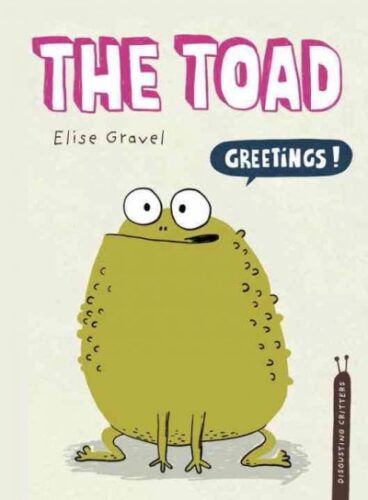
I’m a big fan of all the Gravel series titles. Of the titles out this year, the toad stole my heart. Maybe because I used to catch them in my backyard as a kid. Maybe just because this book’s the funniest.
The Tragic Tale of the Great Auk by Jan Thornhill

I’m a little ashamed to admit that I had no idea what a Great Auk even was before I read this book. Or, for that matter, that they were gone. Sometimes it feels like the passenger pigeon and the dodo get all the press. Poor auks.
Under Earth / Under Water by Aleksandra Mizielinska and Daniel Mizielinski
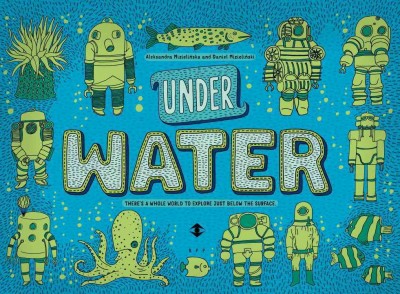
Leave it to the Polish to do something this cool. My kids just dive into this book (no pun intended) since there are so many tiny elements to adore. Again, no backmatter to speak of (European nonfiction titles have that in common) but still awesome. And huge!
What Milly Did: The Remarkable Pioneer of Plastics Recycling by Elise Moser, ill. Scot Ritchie
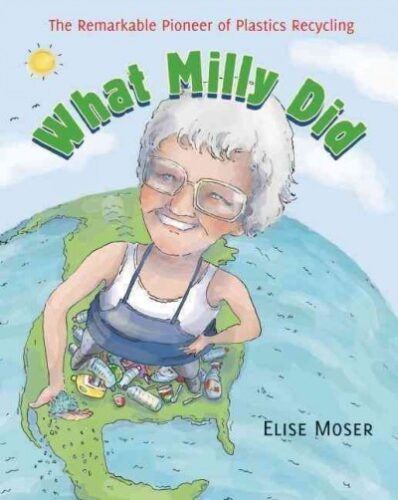
Ever stop to consider the fact that recycling plastics is a relatively new idea? How did it get officially started by vast numbers of cities around the country? A little old woman figured it all out. I love unexpected heroines.
Whoosh! Lonnie Johnson’s Super-Soaking Stream of Inventions by Chris Barton, ill. Don Tate
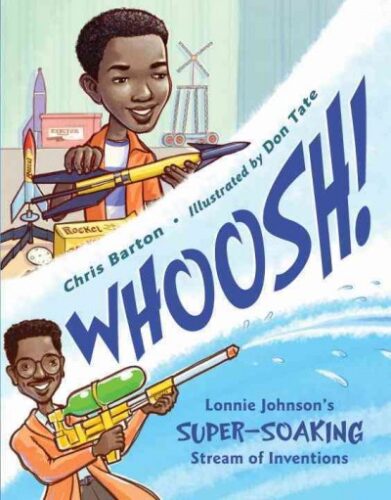
I’m keen on unexpected heroes too. This book is great because it shows that you don’t have to come up with polio vaccine to be considered an inventor. Plus this guy (A) made something cool and (B) is still alive! Once in a while you get a kid in your library who has to check out a bio on someone still alive. Now you’ve an ace in your back pocket.
Whose Eye Am I? by Shelley Rotner

Look them in the eye and tell them you’re not interested in this book. Go on. Tell them.
Interested in the other lists of the month? Here’s the schedule so that you can keep checking back:
December 1 – Board Books
December 2 – Board Book Adaptations
December 3 – Nursery Rhymes
December 4 – Picture Book Readalouds
December 5 – Rhyming Picture Books
December 6 – Alphabet Books
December 7 – Funny Picture Books
December 8 – Calde-Nots
December 9 – Picture Book Reprints
December 10 – Math Picture Books
December 11 – Bilingual Books
December 12 – International Imports
December 13 – Books with a Message
December 14 – Fabulous Photography
December 15 – Fairy Tales / Folktales
December 16 – Oddest Books of the Year
December 17 – Older Picture Books
December 18 – Easy Books
December 19 – Early Chapter Books
December 20 – Graphic Novels
December 21 – Poetry
December 22 – Fictionalized Nonfiction
December 23 – American History
December 24 – Science & Nature Books
December 25 – Transcendent Holiday Titles
December 26 – Unique Biographies
December 27 – Nonfiction Picture Books
December 28 – Nonfiction Chapter Books
December 29 – Novel Reprints
December 30 – Novels
December 31 – Picture Books

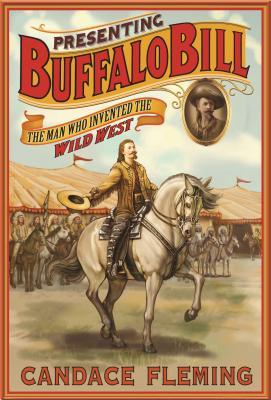 Presenting Buffalo Bill: The Man Who Invented the Wild West
Presenting Buffalo Bill: The Man Who Invented the Wild West
By Candace Fleming
A Neal Porter Book, Roaring Book Press (a division of Macmillan)
$19.99
ISBN: 9781596437630
Ages 9-12
On shelves September 20th
I’ve been thinking a lot lately about how we present history to our kids. Specifically I was thinking about picture book biographies and whether or not they’re capable of offering a nuanced perspective on a person’s complicated life. Will we ever see an honest picture book biography of Nixon, for example? In talking with a nonfiction author for children the other day, she asked me about middle grade books (books written for 9-12 year olds) and whether or not they are ever capable of featuring complicated subjects. I responded that often they’re capable of showing all kinds of sides to a person. Consider Laura Amy Schlitz’s delightful The Hero Schliemann or Candace Fleming’s The Great and Only Barnum. Great books about so-so people. And Candace Fleming… now there’s an author clearly drawn to historical characters with slippery slidey morals. Her latest book, Presenting Buffalo Bill is a splendid example of precisely that. Not quite a shyster, but by no means possessing a soul as pure as unblemished snow, had you asked me, prior to my reading this book, whether or not it was even possible to write a biography for children about him my answer would have been an unqualified nope. Somehow, Ms. Fleming has managed it. As tangled and thorny a life as ever you read, Fleming deftly shows how perceptions of the American West that persist to this day can all be traced to Buffalo Bill Cody. For good or for ill.
What do you think of when you think of the iconic American West? Cowboys and sage? American Indians and buffalo? Whatever is popping up in your head right now, if it’s a stereotypical scene, you’ve Buffalo Bill Cody to thank for it. An ornery son of a reluctant abolitionist, Bill grew up in a large family in pre-Civil War Kansas. Thanks to his father’s early death, Bill was expected to make money at a pretty young age. Before he knew it, he was trying his luck panning gold, learning the finer points of cowboy basics, and accompanying wagon trains. He served in the Civil War, met the love of his life, and gave tours to rich Easterners looking for adventure. It was in this way that Bill unwittingly found himself the subject of a popular paperback series, and from that he was able to parlay his fame into a stage show. That was just a hop, skip, and a jump to creating his Wild West Show. But was Bill a hero or a shyster? Did he exploit his Indian workers or offer them economic opportunities otherwise unavailable to them? Was he a caring man or a philanderer? The answer: Yes. And along the way he may have influenced how the world saw the United States of America itself.
 So let’s get back to that earlier question of whether or not you can feature a person with questionable ethics in a biography written for children. It really all just boils down to a question of what the point of children’s biographies is in the first place. Are they meant to inspire, or simply inform, or some kind of combination of both? In the case of unreliable Bill, the self-made man (I’m suddenly hearing Jerry Seinfeld’s voice saying to George Costanza, “You’re really made something of yourself”) Candace Fleming had to wade through loads of inaccurate data produced, in many cases, by Bill himself. To combat this problem, Ms. Fleming employs a regular interstitial segment in the book called “Panning for the Truth” in which she tries to pry some grain of truth out of the bombast. If a person loves making up the story of their own life, how do you ever know what the truth is? Yet in many ways, this is the crux of Bill’s story. He was a storyteller, and to prop himself up he had to, in a sense, prop up the country’s belief in its own mythology. As he was an embodiment of that mythology, he had a vested interest in hyping what he believed made the United States unique. Taking that same message to other countries in the world, he propagated a myth that many still believe in today. Therefore the story of Bill isn’t merely the story of one man, but of a way people think about our country. Bill was merely the vessel. The message has outlived him.
So let’s get back to that earlier question of whether or not you can feature a person with questionable ethics in a biography written for children. It really all just boils down to a question of what the point of children’s biographies is in the first place. Are they meant to inspire, or simply inform, or some kind of combination of both? In the case of unreliable Bill, the self-made man (I’m suddenly hearing Jerry Seinfeld’s voice saying to George Costanza, “You’re really made something of yourself”) Candace Fleming had to wade through loads of inaccurate data produced, in many cases, by Bill himself. To combat this problem, Ms. Fleming employs a regular interstitial segment in the book called “Panning for the Truth” in which she tries to pry some grain of truth out of the bombast. If a person loves making up the story of their own life, how do you ever know what the truth is? Yet in many ways, this is the crux of Bill’s story. He was a storyteller, and to prop himself up he had to, in a sense, prop up the country’s belief in its own mythology. As he was an embodiment of that mythology, he had a vested interest in hyping what he believed made the United States unique. Taking that same message to other countries in the world, he propagated a myth that many still believe in today. Therefore the story of Bill isn’t merely the story of one man, but of a way people think about our country. Bill was merely the vessel. The message has outlived him.
I’ve heard folks online say of the book that they can’t imagine the child who’d come in seeking a bio of Buffalo Bill. Since kids don’t like cowboys like they used to, the very existence of this book in the universe puzzles them. Well, putting aside the fact that enjoying a biography often has very little to do with the fact that you already were interested in the subject (or any nonfiction book, for that matter), let’s just pick apart precisely why a kid might get a lot out of reading about Bill. He was, as I have mentioned, a humbug. But he was also for more than that. He was a fascinating mix of good and evil. He took credit for terrible deeds but also participated in charitable acts (whether out of a sense of obligation or mere money is a question in and of itself). He no longer fits the mold of what we consider a hero to be. He also doesn’t fit the mold of a villain. So what does that leave us with? A very interesting human being and those, truth be told, make for the best biographies for kids.
 The fact that Bill is a subject of less than sterling personal qualities is not what makes this book as difficult as it is to write (though it doesn’t help). The real problem with Bill comes right down to his relationships with American Indians. How do we in the 21st century come to terms with Bill’s very white, very 19th century attitudes towards Native Americans? Fleming tackles this head on. First and foremost, she begins the book with “A Note From the Author” where she explains why she would use one term or another to describe the Native Americans in this book, ending with the sentence, “Always my intention when referring to people outside my own cultural heritage is to be respectful and accurate.” Next, she does her research. Primary sources are key, but so is work at the McCracken Research Library at the Buffalo Bill Center of the West in Cody, Wyoming. Her work was then vetted by Dr. Jeffrey Means (Enrolled Member of the Oglala Sioux Tribe), Associate Professor of History at the University of Wyoming in the field of Native American History, amongst others. I was also very taken with the parts of the book that quote Oglala scholar Vine Deloria Jr., explaining at length why Native performers worked for Buffalo Bill and what it meant for their communities.
The fact that Bill is a subject of less than sterling personal qualities is not what makes this book as difficult as it is to write (though it doesn’t help). The real problem with Bill comes right down to his relationships with American Indians. How do we in the 21st century come to terms with Bill’s very white, very 19th century attitudes towards Native Americans? Fleming tackles this head on. First and foremost, she begins the book with “A Note From the Author” where she explains why she would use one term or another to describe the Native Americans in this book, ending with the sentence, “Always my intention when referring to people outside my own cultural heritage is to be respectful and accurate.” Next, she does her research. Primary sources are key, but so is work at the McCracken Research Library at the Buffalo Bill Center of the West in Cody, Wyoming. Her work was then vetted by Dr. Jeffrey Means (Enrolled Member of the Oglala Sioux Tribe), Associate Professor of History at the University of Wyoming in the field of Native American History, amongst others. I was also very taken with the parts of the book that quote Oglala scholar Vine Deloria Jr., explaining at length why Native performers worked for Buffalo Bill and what it meant for their communities.
What surprised me the most about the book was that I walked into it with the pretty clear perception that Bill was a “bad man”. A guy who hires American Indians to continually lose or be exploited as part of some traveling show meant to make white Americans feel superior? Yeah. Not on board with that. But as ever, the truth is far more complicated than that. Fleming delves deep not just into the inherently racist underpinnings of Bill’s life, but also its contradictions. Bill hated Custer when he knew the guy and said publicly that the defeat of Custer was no massacre, yet would reenact it as part of his show, 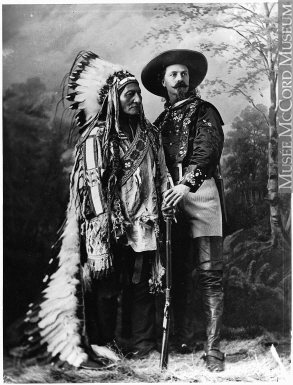 with Custer as the glorified dead hero. He would hire Native performers, pay them a living wage, and speak highly of them, yet at the same time he murdered a young Cheyenne named Yellow Hair and scalped him for his own glory. Fleming is at her best when she recounts the relationship of Bill and Sitting Bull. A photo of the two shows them standing together “as equals . . . but it is obvious that Bill is leading the way while Sitting Bull appears to be giving in. What was the subtext of the photo? That the ‘friendship’ offered in the photograph – and in Wild West performances – honored American Indian dignity only at the expense of surrender to white dominance and control.”
with Custer as the glorified dead hero. He would hire Native performers, pay them a living wage, and speak highly of them, yet at the same time he murdered a young Cheyenne named Yellow Hair and scalped him for his own glory. Fleming is at her best when she recounts the relationship of Bill and Sitting Bull. A photo of the two shows them standing together “as equals . . . but it is obvious that Bill is leading the way while Sitting Bull appears to be giving in. What was the subtext of the photo? That the ‘friendship’ offered in the photograph – and in Wild West performances – honored American Indian dignity only at the expense of surrender to white dominance and control.”
I’m writing this review in the year of 2016 – a year when Donald Trump is running for President of the United States of America. It’s given me a lot of food for thought about American humbuggery. Here in the States, we’ve created a kind of homegrown demagoguery that lauds the successful humbug. P.T. Barnum was a part of that. Huey Long had it down. And Buffalo Bill may have been a different version of these men, but I’d say he belongs to their club. There’s a thin line between “self-made man” and “making stuff up”. Thinner still when the man in question does as much good and as much evil as Buffalo Bill Cody. Fleming walks a tightrope here and I’d say it’s fair to say she doesn’t fall. The sheer difficulty of the subject matter and her aplomb at handling the topic puts her on a higher plane than your average middle grade biography. Will kids seek out Buffalo Bill’s story? I have no idea, but I can guarantee that for those they do they’ll encounter a life and a man that they will never forget.
On shelves September 20th.
Source: Galley sent from publisher for review.
Like This? Then Try:
Professional Reviews:

 Samurai Rising: The Epic Life of Minamoto Yoshitsune
Samurai Rising: The Epic Life of Minamoto Yoshitsune
By Pamela S. Turner
Illustrated by Gareth Hinds
Charlesbridge
$16.95
ISBN: 9781580895842
Ages 10 and up
On shelves now
When you read enough children’s books published in a single year, folks tend to believe that you’ve an ability to spot trends in the general literature. Trend-spotting is easy enough when you’re dealing with picture books (hot in 2016: Bears rampaging through picnics and blobfish!) but books written for older readers are trickier. I think I’ve hit on at least one incredibly popular trend for the current year, however: Overwhelming depression and sadness. Whether it’s baby foxes are getting their legs blown off in landmines, dads being deadbeat, or girls falling down wells, 2016 is officially The Year of the Hankie. So you can imagine the glee with which I devoured Samurai Rising. “A samurai fights for honor and survival in a real-life Game of Thrones,” reads the blurb for the book (minus the torture and nudity, of course). In producing a fantastic look at the true story behind Japan’s most famous samurai, Turner doesn’t just cheer up an otherwise depressed literary year. She highlights a figure too long ignored in America. Say goodbye to boredom. Say hello to crazy-eyed heroics and an anti-hero for the young masses.
On the book’s title page is written a small alert. “WARNING: Very few people in this story die of natural causes.” No lie, just fact. This is the story of Minamoto Yoshitsune. A boy who “could not yet walk when his father left him a lost war, a shattered family, and a bitter enemy.” Yoshitsune’s father (not the brightest samurai of all time) throws away his family’s comfortable existence protecting Japan’s Retired Emperor when he decides to kidnap the guy instead. Swiftly defeated by his rival Taira Kiyomori, the man’s son, little Yoshitsune, is spared but eventually sent to train as a monk. Determined to win back his family’s honor, the boy runs away and with the help of a friendly lord becomes a full fledged samurai. Not a moment too soon either. Forces are brewing and Yoshitsune’s older brother Yoritomo needs his brother’s help to revolt against Kiyomori’s reign. Through it all, Yoshitsune doesn’t just show the heart of a warrior. He shows he has the guts and brains to carry out even the craziest campaign. But with trouble brewing at home, it may be his own family that proves the deadliest enemy of all. Author’s Notes, Time Lines, a Glossary, Chapter Notes, and a Bibliography appear as well.
I was at a conference recently where the terms “creative nonfiction” and “narrative nonfiction” got tossed about like so many ping-pong balls. These terms are generally produced when someone writes a work of nonfiction that reads like a novel. In order to do this and yet still retain even a modicum of historical accuracy, the author in question must bend over backwards to get everything right. Fifty-whopping-two pages, or so, at the back of the book are dedicated to Turner’s chapter notes alone. Here you’ll find every quotation and historical detail cited (Turner also writes an intro to these notes, marking this as the first time I’ve ever seen an author sell the reader on reading them, since who could resist trying to figure out, “why Yoritomo didn’t use ninjas”?). As for Turner’s writing, you forget almost instantly that this is a work of nonfiction. This is both a good and bad thing. Good, because it proves to young readers that there’s more to nonfiction than what you’ll find in a textbook. Bad because life, unlike fiction, doesn’t always adhere to our understanding of narrative rise and fall. When Minamoto’s enemy Kiyomori died without ever having confronted Yoshitsune, I was momentarily baffled. Of course Turner, skillful as she is, is able to naturally call upon Yoshitsune’s older brother as the new enemy, and it’s done with slow, exquisite care.
When you’re watching a musical, the songs have to serve the story. You can’t just have characters burst into a melody without a reason. Likewise, a nonfiction book can be laden with facts, but only if they serve the narrative to its best advantage. Turner has all kinds of tricks up her sleeves, and integrating facts into the story is one of her greater strengths. She can move from the story of Yoshitsune learning how to be a samurai to a description of the brilliant work of engineering that is a samurai’s armor or sword with aplomb.
Even with all this, Turner’s working at a natural disadvantage. Her story is set in the 12th century. Source material from that time? Not exactly copious. So she relies upon informed speculation, i.e. what a character may have seen or may have considered in one scene or another. A number of years ago I read a book called Wild Boy: The Real Life of the Savage of Aveyron which was a true history of a child who lived in the wild and was brought back to “civilization” near the end of the French Revolution. The author leaned heavily on a plethora of “probablys” which is no crime. Honestly, it informs the reader as to what they do or do not know. Still, it can prove distracting if too many are clustered in one spot. The only time I found myself irked in a similar way here was around the beginning of the book when Minamoto and a gold merchant were avoiding the samurai. From “the homey smell of wood smoke probably drew the weary travelers to wayside inns” to “The teenage runaway probably watched, mouth agape, as entertainers performed the popular tales of his time”, I found my willingness to go along with Turner’s speculations stretched, if never quite broken. Fortunately it’s the only time in the book I found Turner’s reliance on probability too overt. For the most part, she does a fine job of keeping everything copacetic.
I was also taken with the humor of the book. Judicious use of it in any nonfiction title is a delicate art. Here, the author has the advantage of time (no one’s going to read about the beheadings of the 1100s and think “Too soon!”). So when she pulls out lines like “News of severed heads travels fast,” you can’t but help but admire the wordplay’s moxie. Ditto, “If things went badly, Kiso had the usual samurai backup plan: kidnap the Retired Emperor” (this line works better after you see how many times the poor guy gets kidnapped in the course of his life – a calming retirement it is not).
The inclusion of Gareth Hinds’ art in the book was good planning on someone’s part (mostly likely Art Director Susan Sherman, according to Turner’s Acknowledgements). Though he’s illustrated the occasional title for other authors (Gifts from the Gods) generally Gareth sticks to his own graphic novel adaptations of classics like The Odyssey or Beowulf or King Lear. A meticulous hand, Hinds’ interstitial art keeps the narrative moving without distracting from it. And while it did have the odd personal problem of making me really want a Minamoto Yoshitsune graphic novel (ahem ahem!), for the most part I think it’ll be of greatest use to those students that need a little visual stimulation with their descriptive texts.
Here’s a pretty basic question for the book: Is Minamoto a hero? The comparison to Game of Thrones on the book’s blurb isn’t all that wrong. Things get pretty ethically dicey in the midst of power plays and wars. Honestly, coming out of this book I had particular sympathy for two people in particular and neither one of them was Minamoto. Minamoto’s heroism in terms of bravery cannot be called into question, but if we’re trying to figure out why he comes across as sympathetic, a lot of that can be attributed to our innate sense of fairness, or lack thereof. He starts off clawing his way up, already at a disadvantage thanks to dear old dad, and then just when everything seems to be working out for him his own brother stabs him in the back (figuratively and nearly literally). He deals decently at times, establishing law and order at critical moments. Then again, he’s not against lighting the occasional peasant village on fire like some insane 12th century version of streetlights. And so I say to teachers and the leaders of bookgroups, if you are doing this book with a group of kids and you need a topic of discussion, just ask this: What is a hero? You’re bound to get some pretty interesting answers after the kids read this book.
As I write this review, the hottest musical on Broadway right now is Hamilton by Lin-Manuel Miranda. It seems to me that we’re seeing a lot of narratives right now that discuss scrappy youngsters, eager to make their mark on the world, no matter the cost to themselves or others. So hey, if you need an idea for a new musical, have I got a book for you! Bringing to the attention of American kids new historical heroes from cultures they may not have any familiarity with is a difficult proposition. Turner and Hinds tackle the challenge with a kind of manic glee. The end result is infinitely readable and downright fun. So pile on the other tear-drenched novels for the kiddos. As long as I have a plucky samurai kid not throwing away his shot I’ll be satisfied. More fun than it deserves to be and a great read.
On shelves now.
Source: Galley sent from publisher for review.
Like This? Then Try:
Videos:
And, naturally, it has a trailer:

 There were no science books on the YALSA Award for Excellence in Nonfiction for 2016. Nor in 2015. Nor 2014. Bomb in 2013 was sort of a science book, so we’ll count that. And Moonbird that year certainly was. Yet it’s often surprising how consistently science and nature get overlooked when they’re handing out awards for nonfiction. According to my sources, science writers are complaining about this fact, and with good reason. When you create an award for nonfiction and then hand it consistently to biographies, you are, however unintentionally, sending a message.
There were no science books on the YALSA Award for Excellence in Nonfiction for 2016. Nor in 2015. Nor 2014. Bomb in 2013 was sort of a science book, so we’ll count that. And Moonbird that year certainly was. Yet it’s often surprising how consistently science and nature get overlooked when they’re handing out awards for nonfiction. According to my sources, science writers are complaining about this fact, and with good reason. When you create an award for nonfiction and then hand it consistently to biographies, you are, however unintentionally, sending a message.











































THEY ALL SAW A CAT is also a fabulous book for science discussions, since it is about the different ways animals perceive the world around them. Okay, maybe it isn’t one of those books with a lot of back-matter to answer questions, but it generates questions like crazy, and inquiry is the essence of science, n’est ce pas?
I have loved these lists! They have been like the best Advent calendar ever! Thank you for doing them.
Thank you so much for including Coyote Moon on this list, Betsy!! What a thrill to see it here, and a nice holiday present :).
I also loved The Tragic Tale of the Great Auk, and it made me weep (though granted these days I am far more weepier than normal). It is tragic indeed! And I hadn’t heard of Deep Roots–I will look for it, and the others that I haven’t yet read from your list (I’ve read 19 of theses :).)
I do love PB bios, but it would be great to see sciency-book get book award nods too.
Hmmm. Stretching it but tis the season. I’ll give it to you!
What a great list! There are several titles here that I haven’t read yet and can’t wait to get my hands on.